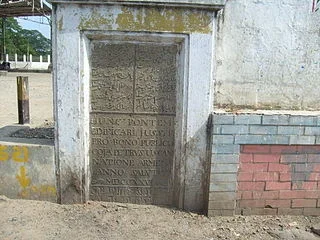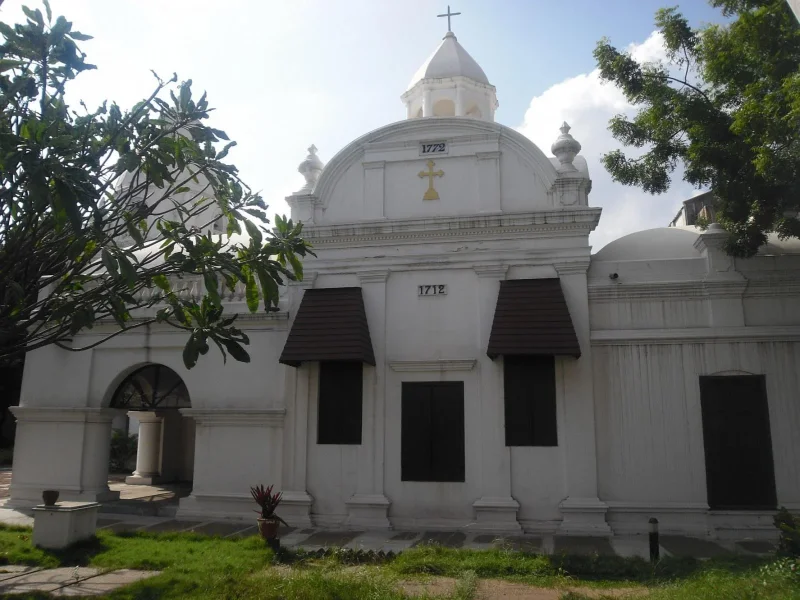Brahmanyan
Active member
Armenians in Madras:
Many of us who visit or live in Chennai (Madras) have passed through the busy Street known as Armenian Street, in George Town. Which is called as Aramanaikaara Theru ( அரண்மனைக்கார தெரு) in Tamil. But may not be aware of the fact that this name carries an interesting piece of History of Madras behind it. In the seventeenth and eighteenth centuries there lived an enterprising group of Armenian Merchants in Madras doing local trade and exports successfully in Textiles, precious stones, silks and spices. Armenians, who came from a small landlocked mountainous Country in the Caucuses region of Eurasia, were devout Christians. The Armenian Merchants in Madras built the first Church in 1712 at the esplanade, but have to be demolished due to objection from the British, However rebuilt the present church in 1772 at the Armenian Street which is known as St. Mary's Church. The belfry which has six bells - all cast at London's Whitechapel Bell Foundry is considered to hold the largest number of bells in any church in Tamilnadu. This Church is considered one of the oldest in India..
 Khojah Petruss Woskan (Uscan) (1681-1751) was one among the rich Armenian Traders. He was a member of the Governing Council of the East India Company. Due to his proximity to the Nawab of Arcot, he got exclusive trading concessions and became rich millionaire and spent a large portion of his wealth in welfare activities. He built the "Marmalong Bridge" (The village Marmalong or Marmalan is identified with Mambalam ) across the Adyar river in 1726 in Saidapet at his personal cost. This bridge was in use till 1960 when a new bridge was constructed and named "Maraimalai Adigal palam". Also he left a huge sum with the authorities for its maintenance. A stone plaque commemorating the construction of "Marmalong" Bridge with inscriptions in Persian and Latin can still be seen behind the new bridge at the northern side.
Khojah Petruss Woskan (Uscan) (1681-1751) was one among the rich Armenian Traders. He was a member of the Governing Council of the East India Company. Due to his proximity to the Nawab of Arcot, he got exclusive trading concessions and became rich millionaire and spent a large portion of his wealth in welfare activities. He built the "Marmalong Bridge" (The village Marmalong or Marmalan is identified with Mambalam ) across the Adyar river in 1726 in Saidapet at his personal cost. This bridge was in use till 1960 when a new bridge was constructed and named "Maraimalai Adigal palam". Also he left a huge sum with the authorities for its maintenance. A stone plaque commemorating the construction of "Marmalong" Bridge with inscriptions in Persian and Latin can still be seen behind the new bridge at the northern side.
Being a devout Christian, Petruss Woskan donated lavishly for Christian religious endowments. He was one of the foremost contributors for building St Rita's church in St Thome in 1729.. He had also built 160 stone steps leading to the top of St. Thomas mount at Madras, where the Church of St. Thomas was built on the reputed site of martyrdom of the Apostle. The pictures of twelve Apostles inside the Church are in Armenian language.
Petrus Woskan died in 1751 in Madras. His tomb can be seen in St.Matthias' Church, (formerly Chapel Nossa Senhora de Milagres, private chapel of PetrussWoskan), Vepery, Chennai.
The Armenians arrived in India following the East India Company to trade and seek their fortunes. In fact, the East India Company valued the Armenians for their, "sober, frugal and wise" habits and accorded them the equal rights as English traders in 1688. Once a thriving community in Madras as well as in Calcutta, the Armenians brought with them their distinct language, culture and religion. The Pay and Account Office, Pantheon buildings and the Umda Bagh building in the Quaid-E-Millath College for Women are some of the buildings that were once owned by the Armenians, that is part of the rich Armenian heritage the city once had.
Rich heritage of Madras can be found in every stone of old Madras. All that it needs is our interest in them.
Regards,
Brahmanyan,
Bangalore.
Many of us who visit or live in Chennai (Madras) have passed through the busy Street known as Armenian Street, in George Town. Which is called as Aramanaikaara Theru ( அரண்மனைக்கார தெரு) in Tamil. But may not be aware of the fact that this name carries an interesting piece of History of Madras behind it. In the seventeenth and eighteenth centuries there lived an enterprising group of Armenian Merchants in Madras doing local trade and exports successfully in Textiles, precious stones, silks and spices. Armenians, who came from a small landlocked mountainous Country in the Caucuses region of Eurasia, were devout Christians. The Armenian Merchants in Madras built the first Church in 1712 at the esplanade, but have to be demolished due to objection from the British, However rebuilt the present church in 1772 at the Armenian Street which is known as St. Mary's Church. The belfry which has six bells - all cast at London's Whitechapel Bell Foundry is considered to hold the largest number of bells in any church in Tamilnadu. This Church is considered one of the oldest in India..
 Khojah Petruss Woskan (Uscan) (1681-1751) was one among the rich Armenian Traders. He was a member of the Governing Council of the East India Company. Due to his proximity to the Nawab of Arcot, he got exclusive trading concessions and became rich millionaire and spent a large portion of his wealth in welfare activities. He built the "Marmalong Bridge" (The village Marmalong or Marmalan is identified with Mambalam ) across the Adyar river in 1726 in Saidapet at his personal cost. This bridge was in use till 1960 when a new bridge was constructed and named "Maraimalai Adigal palam". Also he left a huge sum with the authorities for its maintenance. A stone plaque commemorating the construction of "Marmalong" Bridge with inscriptions in Persian and Latin can still be seen behind the new bridge at the northern side.
Khojah Petruss Woskan (Uscan) (1681-1751) was one among the rich Armenian Traders. He was a member of the Governing Council of the East India Company. Due to his proximity to the Nawab of Arcot, he got exclusive trading concessions and became rich millionaire and spent a large portion of his wealth in welfare activities. He built the "Marmalong Bridge" (The village Marmalong or Marmalan is identified with Mambalam ) across the Adyar river in 1726 in Saidapet at his personal cost. This bridge was in use till 1960 when a new bridge was constructed and named "Maraimalai Adigal palam". Also he left a huge sum with the authorities for its maintenance. A stone plaque commemorating the construction of "Marmalong" Bridge with inscriptions in Persian and Latin can still be seen behind the new bridge at the northern side.Being a devout Christian, Petruss Woskan donated lavishly for Christian religious endowments. He was one of the foremost contributors for building St Rita's church in St Thome in 1729.. He had also built 160 stone steps leading to the top of St. Thomas mount at Madras, where the Church of St. Thomas was built on the reputed site of martyrdom of the Apostle. The pictures of twelve Apostles inside the Church are in Armenian language.
Petrus Woskan died in 1751 in Madras. His tomb can be seen in St.Matthias' Church, (formerly Chapel Nossa Senhora de Milagres, private chapel of PetrussWoskan), Vepery, Chennai.
The Armenians arrived in India following the East India Company to trade and seek their fortunes. In fact, the East India Company valued the Armenians for their, "sober, frugal and wise" habits and accorded them the equal rights as English traders in 1688. Once a thriving community in Madras as well as in Calcutta, the Armenians brought with them their distinct language, culture and religion. The Pay and Account Office, Pantheon buildings and the Umda Bagh building in the Quaid-E-Millath College for Women are some of the buildings that were once owned by the Armenians, that is part of the rich Armenian heritage the city once had.
Rich heritage of Madras can be found in every stone of old Madras. All that it needs is our interest in them.
Regards,
Brahmanyan,
Bangalore.
Attachments
Last edited:

